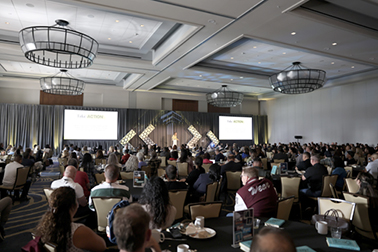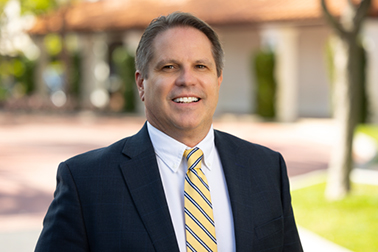Issue 164 - October 2025
NEWS: WORTHY

Authority Members Gather for Class of ’95: Not So Clueless About Risk at 30th Annual Risk Management Educational Forum
A total of 500 Authority members, business partners, and staff engaged with speakers and learned from relevant and timely presentations at the California JPIA’s 30th Annual Risk Management Educational Forum, themed, Class of ’95: Not So Clueless About Risk, at the Omni La Costa in Carlsbad from October 1 to 3, 2025.
The event kicked off with a panel discussion on how the City of Santa Monica implemented a comprehensive youth protection program with the support of Praesidium services in the session, “All That and a Bag of Chips: Strengthening Youth Protection—The Praesidium-Public Agency Success Story.” Then, Jacob Houghton inspired attendees to look inward to strengthen trust within their teams and agencies in the session, “Stop, Collaborate, and Listen: Effective Tools for Building Trust in Local Government.”
Thursday’s programming started with the recognition of the Capstone Award finalists. The award is presented each year to an individual at a member agency who best exemplifies risk management. Dorna Farhadi, human resources manager at the City of Laguna Niguel, received the 12th Annual Capstone Award.
Erin Stafford, a social psychologist, author, and burnout expert, delivered a dynamic and engaging keynote discussion on how to avoid burnout by recharging and having daily moments of joy.
Breakout sessions addressed risk management issues affecting public agencies. Members immersed themselves in topics such as legal liability, workers’ compensation, cybersecurity, avoiding special event liability, managing complaints against elected officials, governance, and ADA compliance. The Forum agenda provides a complete listing of breakout sessions.
The Forum concluded on Friday with a candid and practical discussion about the 2024 Los Angeles-area wildfires featuring Traci Park, councilmember for District 11. Park’s session, “Out of the Firestorm: Crisis Communications—Studying the L.A. Wildfires,” provided practical techniques for real-time updates, media coordination, and effective message prioritization to maintain public trust during emergencies.
Save the date for the 31st Annual California JPIA Risk Management Educational Forum, October 7–9, 2026, at the Monterey Conference Center in Monterey.
Print Article
California JPIA Recognizes Capstone Award Winner Dorna Farhadi
The California JPIA congratulates City of Laguna Niguel Human Resources Manager Dorna Farhadi, who received the 12th annual Capstone Award at the California JPIA’s Annual Risk Management Educational Forum in Carlsbad.
“Dorna has built a proactive and hands-on risk management program, with safety at its core. Her leadership and follow-through have been key to its success,” said Laguna Niguel City Manager Tammy Letourneau. “Her open-door approach and strong relationships with staff have built trust across the organization, and her hands-on leadership and proactive risk management help resolve issues before they arise.”
Since stepping into the role of designated risk manager for the City of Laguna Niguel, Farhadi has placed a strong focus on enhancing risk mitigation efforts through education and the development of standardized resources, including guides and workflow processes. Farhadi has also been very intentional about providing many training opportunities, both in-person and virtual, which have led to impactful change and a more well-trained staff throughout the organization.
“Keeping best practices and training materials up to date is essential for maintaining compliance and reducing legal risk,” said Farhadi. “It also strengthens staff preparedness and promotes the sharing of risk-related knowledge across departments.”
“Dorna brings a people-first approach to risk management, making complex policies accessible and engaging staff at all levels,” said Laguna Niguel Assistant City Manager Justin Martin. “Her ability to connect has strengthened our overall strategy and led to meaningful results.”
At Farhadi’s helm, the city worked closely with the Authority to address significant risk concerns related to the reconstruction of a major arterial damaged by a landslide two years ago. As part of the $16 million repair project, the city carefully evaluated construction-related risks to establish appropriate insurance policy limits—striking a balance between protecting municipal interests and remaining fair to contractors.
“Dorna adds value in so many ways. She goes beyond checking boxes—she builds systems that integrate safety into every part of the organization,” said Senior Risk Manager Lucy Brockmeier. “Her leadership has helped position Laguna Niguel to be named an agency exemplar within the JPIA community.”
Farhadi has also led the development of a city Wellness Program, which focuses on staff well-being. Offerings include a monthly wellness newsletter, healthy recipes, and physical challenges.
“My goal is to continue to be a leader in enhancing risk management efforts and to minimize overall risk for the city through effective communication internally across all city departments, and through the implementation of best practices citywide,” said Farhadi.
The Capstone Award is presented annually to an individual at a member agency who exemplifies the practice of risk management by supporting or improving risk management efforts within their agency, influencing others in developing or maintaining positive risk management efforts, and coordinating support systems that serve the member’s risk management goals and needs.
The 2025 finalists also included:
- Kristi Hobrecker, City of Santa Clarita
- Pam Kobylarz, Town of Mammoth Lakes
- Kevin McCarthy, City of Indian Wells, and
- Josephine Wilson, City of Westlake Village
To learn more about the Capstone Award and view the finalist videos, visit the award webpage.
Print Article
November Workers’ Compensation Webinar— Legislative Update
The California JPIA will host its next Workers’ Compensation Webinar on Thursday, November 13, at 10:00 a.m. Join us for insights from one of Sacramento’s leading lobbyists, including a recap of the 2025 legislative session and a look ahead to 2026.
Faith Borges has been involved in legislative affairs for over a decade and is a founding partner of Public Policy Partnership. Borges is finishing her ninth year as a lobbyist for the California Association of Joint Powers Authorities (CAJPA), where she advocates on behalf of public agencies throughout California on key issues, including workers’ compensation. She holds a Bachelor of Arts degree in Political Science from the University of California, Santa Barbara, and completed a graduate certificate in Applied Policy and Government as a California Senate Fellow at Sacramento State University.
We look forward to having you join us on November 13. Register here for the webinar. For those unable to attend the live webinar, a recording will be available on the Authority’s website. For any questions, please contact Workers’ Compensation Program Manager Jeff Rush.
Print Article
2026 Academies and Summits: A Look Ahead
By Michelle Aguayo, Training CoordinatorEducational development is a cornerstone of the California JPIA’s training program, and the 2026 academies and summits will once again provide immersive, multi-day learning experiences in dynamic settings designed to inspire growth and collaboration. Several classic academies have been reconfigured with new content from trusted subject matter experts.
Attendees are encouraged to actively engage during the sessions, which feature collaborative group activities with their peers. The academies and summits are designed to create a well-rounded learning environment and help Authority members bring back real-world examples and actionable information to enhance their work-life balance.
Here are the scheduled academies and summits in 2026:
- Risk Management Academy, February 3–5, Oceanside
- Public Safety Academy, March 10–12, Oxnard
- Elected Officials Summit, April 29–May 1, Chula Vista
- Leadership Academy, May 19–21, Paso Robles
- Human Resources Academy, August 18–20, Chula Vista
- Supervisor Academy, September 22–24, Oceanside
Online registration for each of the above-listed events will open two to three months before their scheduled start date. Members will receive an email containing detailed information and a registration request link once registration opens.
Attendance at academies and summits is limited, and special consideration is given to ensure that as many individual member agencies as possible can participate. It is of the utmost importance that, once confirmed to attend, you remain mindful of the no-show and cancellation policies for each event.
For more information about the California JPIA academies and summits, please contact Training Coordinator Michelle Aguayo.
Print ArticleRE: MEMBERS

Authority Members Lead Regional Efforts on E-Bike Safety
In response to community concerns over the safety and regulation of electric bicycles and similar mobility devices, the cities of Hermosa Beach, Westlake Village, Azusa, and San Clemente have enacted ordinances aimed at curbing unsafe riding behavior in public spaces. Riding on city streets remains permitted, and mobility aids recognized under the Americans with Disabilities Act are exempt from this restriction.
The City of Westlake Village’s ordinance bans e-bikes, electric scooters, and other recreational electric mobility devices from sidewalks, parks, trails, fields, and drainage basins within city limits. Hermosa Beach’s ordinance requires all e-bike riders under the age of 18 to wear helmets, and all passengers must have their own seats. The City of Azusa’s ordinance prohibits the use of e-bikes and motorized scooters in parks, on sidewalks, and in city recreational and government facilities. San Clemente’s ordinance prohibits dangerous riding, including traveling with passengers on an e-bike and performing stunts like wheelies. San Clemente’s new e-bike rules hold parents equally responsible for violations committed by their children, including any fines.
The ordinances come amid a regional uptick in complaints about reckless riding, particularly by minors. According to Westlake Village City Manager Rob de Geus, the affordability and popularity of high-powered electric vehicles have outpaced local governments’ ability to regulate their use. “Electric vehicles, especially e-bikes and e-motorcycles, can reach speeds of over 40 miles per hour, creating a safety hazard for pedestrians and parkgoers,” de Geus noted in a memo to the Westlake Village City Council.
The ordinances empower law enforcement officers to administer the new rules. Additionally, some of the agencies’ ordinances carry escalating fines ranging from $100 to $1,000.
Westlake Village’s ordinance extends sections of the California Vehicle Code, such as those addressing speeding and reckless driving, to all public properties and private lots open to the public, provided appropriate signage is in place.
As other municipalities across Southern California grapple with similar challenges, these agencies’ proactive approach may serve as a model for balancing mobility innovation with public safety.
Building on this momentum, it is equally important for municipalities to adopt a comprehensive strategy that addresses all forms of cycling, not just e-bikes. While much attention has been placed on minors operating high-powered electric bikes, other cyclists, such as those training for races or riding at high speeds, can also pose safety risks when they disregard traffic laws and ride aggressively in shared public spaces. A balanced approach that incorporates education, enforcement, and clearly defined expectations for all riders, regardless of their equipment or experience level, is essential to promoting safer streets and protecting pedestrians, parkgoers, and fellow cyclists alike.
To support these efforts, the California JPIA encourages member agencies to stay informed on developments in e-bike regulation and evaluate how local ordinances and enforcement strategies can be leveraged to mitigate risk and enhance community well-being.
Print Article
City of Carpinteria Celebrates 60th Anniversary
The California JPIA recognizes the City of Carpinteria, which celebrates its 60th Anniversary this year.
The city was incorporated in 1965 and maintains a delicate balance of staying true to its small-town roots while remaining welcoming to visitors. “The city takes pride in its community,” said Senior Risk Manager Tim Karcz. “They have a lot of small, independently owned restaurants and places of business. It’s not a cookie-cutter kind of town—it’s very local.”
The city has completed several significant projects in recent years, including the construction of a skate park adjacent to City Hall. The city also manages extensive wetlands and is coordinating with other agencies on the removal of infrastructure connected to decommissioned offshore oil platforms. Looking ahead, Carpinteria is assuming stewardship of more natural spaces, including cliff areas and trails near the train tracks. “The city’s literally growing in size with this open space that it’s acquiring,” said Karcz. “And with that comes decisions and risk management.”
Carpinteria has been a California JPIA member for 33 years, joining the Authority in 1992. Building on their longstanding membership, the city continues to innovate. They recently formed a team with staff from every department to address liability concerns and safety issues identified in a risk management evaluation.
“They actively involve us and have been wonderful partners of ours for many years,” said Karcz, who has worked with Carpinteria for nearly 10 years and regularly participates in the city’s quarterly all-hands staff meetings to discuss risk management topics.
“The Authority empowers us to not only manage claims effectively but to proactively mitigate risk and liability exposure across our entire organization,” said Assistant City Manager Ryan Kintz. “In the coming years, we look forward to strengthening this partnership by leveraging the California JPIA’s extensive training catalog, collaborating more closely with Tim on new risk-related processes, policies, and procedures, and fully utilizing their dedicated experts and resources. Our collaboration with the Authority is fundamental to building a more resilient and secure future for the City of Carpinteria.”
Congratulations to the City of Carpinteria for 60 years of serving your residents!
Print ArticleRISK SOLUTIONS

To Serve Alcohol or Not to Serve Alcohol, that is the Question
By Maria Galvan, Senior Risk Manager, and Alex Mellor, Risk Services Director
As the holidays approach, many members are preparing for employee recognition parties and other staff gatherings. The question of whether to serve alcohol should be carefully evaluated. Consuming alcohol at workplace parties may encourage inappropriate behavior, which can lead to liability or workers’ compensation claims from employees or claims from third parties due to incidents occurring during or after the event.
Employers (including local government agencies) may be liable for incidents arising out of workplace parties where alcohol is served. Courts evaluate different factors when deciding whether an employer is liable for an employee involved in an accident due to consuming alcohol at an employer’s function. Factors may include whether employees were required to attend, where the event was held, if guests were invited, whether employer business was discussed, and if the event was sponsored or planned by the employer or organized independently by employees.
In the 2013 ruling of Purton v. Marriott International, Inc., the California Fourth District Court of Appeal held the employer liable for a death caused by an employee who became intoxicated at a workplace party. The employee arrived home safely following the party, but then left to drive a co-worker home. The employee then hit another car, killing its driver. The trial court granted summary judgment in favor of the employer because liability under the doctrine of respondeat superior ended when the employee arrived home. However, the appellate court reversed the decision and sent the case back for trial. The appellate court found that because the party benefited the employer by improving employee morale, the employer should be liable for the accident because the proximate cause of the injury (alcohol consumption at the party) occurred within the scope of employment.
The only way to avoid liability arising from serving alcohol at a workplace party is not to serve alcohol. However, if your agency does decide to serve alcohol, the following steps are recommended to minimize liability:
- Ensure that harassment prevention training and substance abuse prevention training has recently been provided, and training records are up to date. Consider policies making clear that excessive consumption of alcohol at agency functions will not be tolerated. Policies may include specific examples of conduct that will not be permitted. If your agency’s policies do not address workplace social events, consider updating them accordingly. Also, remind employees about the dangers and consequences of drinking and driving. Policies should be communicated using various methods: email, paycheck stub memos, bulletin boards, meetings, etc. Signed acknowledgments of receipt and understanding of policies by employees should be obtained.
- Make clear to employees that attendance at agency social events is strictly voluntary and not a requirement of employment. This suggestion applies whether or not alcohol is served.
- Limit the amount and types of alcohol to be served. For example, consider having a cash bar or providing a limited number of drink tickets per person. Sweet alcoholic drinks or punches make it difficult for an individual to know how much they have consumed. In addition, serve plenty of non-alcoholic beverages such as water, sodas, and juices.
- Close the bar one or two hours before the event is over and continue to serve food.
- Hold the event off agency premises at an establishment with professional bartenders and a valid liquor license. Professional bartenders know how to deal with guests consuming alcohol in excess. When hiring professional bartenders or caterers, ensure they carry appropriate general liability and liquor liability insurance. Do not allow employees to serve drinks to co-workers.
- Since workplace parties are typically social, limit the discussion of business and hold the event outside of business hours.
- Consider allowing family and significant others to attend. Inviting guests implies the event is social rather than business-related. In addition, employees are likely to be more reserved and less inclined to participate in offensive behavior. However, if customers or business partners are invited, the function is likely to be viewed as a business event.
- If inviting minor guests, do not serve alcohol.
- Do not allow employees to bring alcohol to an agency event.
- Provide alternative transportation (such as rideshare services) for employees leaving workplace parties where alcohol is served. Encourage employees to have a designated driver.
- Consider scheduling the party earlier in the day so employees are less inclined to drink excessively.
- Do not require non-exempt employees to perform functions at agency social events. This can help to avoid wage and hour claims.
Opinions vary about the wisdom of serving alcohol at workplace parties. Consult legal counsel for advice on your specific situation.
If you have questions, please contact your regional risk manager.
Print Article
Understanding and Managing Employee Exposure to Valley Fever
According to data provided by the California Department of Public Health (CDPH), cases of a respiratory condition known as Valley Fever are on the rise in California. California JPIA members should be aware of potential employee exposure.
Valley Fever is a respiratory condition caused by a microscopic fungus known as Coccidioides immitis. This fungus inhabits the top two to twelve inches of soil in many parts of the state, with the highest rates of exposure occurring in the Central Valley and the Central Coast. When contaminated soil is disturbed by activities such as digging, grading, vehicle operations on dirt roads, or high winds, fungal spores can become airborne and potentially be inhaled by workers. Many people who are exposed never have symptoms, while others experience flu-like symptoms (fever, headaches, aches in upper body and legs) that usually go away on their own after a few weeks. If symptoms last more than a week, medical attention should be sought.
Exposure to Valley Fever can be managed and prevented through a formal Respiratory Protection Program, in conjunction with taking the following steps to reduce worker exposure in areas with high incidence rates:
- Minimize the area of soil disturbed.
- Use water, appropriate soil stabilizers, and/or re-vegetation to reduce airborne dust.
- Stabilize all spoils piles by tarping or other methods.
- Clean tools, equipment, and vehicles before transporting offsite.
- Provide air-conditioned cabs for vehicles that generate heavy dust and make sure workers keep windows and vents closed.
- Suspend work during heavy winds.
- If workers’ clothing is likely to be heavily contaminated with dust, provide coveralls and changing rooms, and showers where possible.
Encourage workers to report Valley Fever symptoms promptly to a supervisor and to follow agency procedures for reporting a work-related injury.
Additional information on Valley Fever is offered through the California JPIA’s Respiratory Protection training program. To schedule a session or for more information, contact our training department. Additional resources can be found from the Centers for Disease Control and Prevention (CDC).
For more information, contact your regional risk manager.
Print ArticlePRO: FILES

Paul Zeglovitch Promoted to Chief Operating Officer
The California JPIA is proud to announce the promotion of Paul Zeglovitch to Chief Operating Officer. Throughout his tenure at the Authority, Paul is known for his sincerity, candor, and pragmatic decision-making, all qualities that will serve him well in this new role.
“Paul exemplifies the core values that define the California JPIA. He operates with excellence and leads with integrity every day. That, combined with his deep knowledge of our members, claims, and litigation, has made him an invaluable part of our team,” said Chief Executive Officer Alex Smith. “His thoughtful leadership will ensure the Authority continues to thrive as we grow and evolve.”
For 17 years, Zeglovitch has been an integral part of the organization, bringing expertise in claims management, litigation oversight, and the development of coverage documents. His ability to cultivate strong relationships with members and business partners has been instrumental in the Authority’s growth and success.
“Being promoted to Chief Operating Officer is an honor,” said Zeglovitch. “It gives me the opportunity and responsibility to help shape the course of the California JPIA in the future, and that is exciting.”
Before joining the Authority, Zeglovitch served as a claims supervisor at Carl Warren & Company for 16 years. He holds a B.A. in business from the State University of New York at Buffalo and is a credentialed Associate in Risk Management (ARM), specializing in public entities. He is currently serving as the president of the Public Agency Risk Management Association (PARMA).
In his new role, Zeglovitch will oversee the following departments: claims and insurance, risk management, and technology and data. “I am excited about the efficiencies we are bringing to our technology department that will benefit both members and staff,” said Zeglovitch. He also noted that the risk management department is evaluating partnerships to provide new programs that will help members mitigate risk. “I’m also looking forward to welcoming new partners to our legal defense panel. They are enthusiastic about being part of the team and forging long-lasting relationships with our members.”
Zeglovitch’s promotion is a testament to his dedication and the trust placed in him by the Executive Committee and leadership team. His vision and experience will continue to guide the Authority as it evolves to meet the needs of members. Zeglovitch continued, “My priorities have been and continue to be ensuring the Authority is a workplace where employees feel valued, respected, and supported, so that they can do their best work.”
Congratulations, Paul, on this well-deserved achievement!
Print ArticleLEGAL MATTERS

Drones—What Public Agencies Need to Know Now to Ensure Compliance and Prepare for Changes Ahead
By: Lauren E. Brown, Supervising Attorney, Civica Law Group, APCCURRENT LANDSCAPE AND RECENT DRIVERS FOR CHANGE
Drones are essential tools for public agencies. As technology, public opinion, and the legal landscape governing their use rapidly evolve, it is imperative to stay informed and act quickly to ensure ongoing compliance and to leverage their use.
Before public agencies can operate drones, they must first follow federal regulations by submitting an application through the Federal Aviation Administration (FAA) to obtain approvals to operate either through rule Part 107 or via a certificate of waiver or authorization (COA). A COA provides the ability to engage in drone operations outside the scope of Part 107, such as:
- Night flights,
- Flights over controlled airspace,
- Flights beyond visual line of sight (BVLOS) operations,
- In emergency situations.
Significant changes are occurring in these approvals, and the operating procedures that agencies have historically followed are changing. 2025 brought the most significant federal updates since the creation of Part 107 in 2016. By early 2026, a new FAA rule (Part 108) will reshape how agencies operate altogether. These changes come to fulfill a presidential directive to accelerate national drone integration.
Most public agencies implementing drone operations have an existing drone policy that sets forth requisite approvals, governs operations, and establishes uniform procedures. With pivotal changes underway and more set to occur in early 2026, now is the time to review these policies for compliance, plan for change, and get ready to implement new drone operations.
Immediate Steps To Ensure Compliance With 2025 Updates
The following are some of the key changes to drone usage in 2025.
Remote IDs
Remote IDs are now mandatory for all drone use unless a specific waiver is obtained granting exemption status. Failure to comply may result in FAA enforcement, such as fines and suspension. To comply, all active drones must broadcast identification and location information in real-time, which can be done either through built-in systems or an approved add-on module for older drones. This is particularly important as law enforcement can now access real-time data, allowing certain drone operators to be instantly identified.
Key Steps to Ensure Compliance:
- Conduct an immediate inventory of all drones and verify Remote ID compliance or exemptions.
- Increase training on broadcast functions and failure protocols, including accounting for loss of signal and safe landing procedures.
- Ensure your existing drone policy accounts for identification requirements and broadcast and failure protocols.
Expanded Permissions: More Flexibility in Public Safety Uses
As the FAA transitions to implement rule Part 108, it has rolled out certain permissions allowing for greater flexibility in public safety drone operations. Specifically, flying over people and moving vehicles is expressly allowed under certain FAA safety categories, and night operations are now authorized without needing a waiver—provided the pilot holds a Part 107 certificate and the drone uses approved anti-collision lighting. These updates represent the first phase of efforts aimed at streamlining the process for public safety use and are designed to facilitate faster deployment for emergency and time-sensitive events.
Modernization of Notice to Airmen (NOTAM)
Notices to Airmen (NOTAMs) alert pilots to temporary airspace restrictions, potential hazards, and operational changes, ensuring that all pilots are adequately informed.
On September 30, 2025, the FAA launched its first phase of the new NOTAM Management Service, replacing the prior system that had experienced nationwide outages and caused several flight delays in past years. The new cloud-based system provides real-time data, modern interfaces, and streamlined information. The aim is for it to be the single authoritative source for all U.S. NOTAMs once the full transition occurs, which is scheduled for spring 2026. Agencies should monitor the FAA’s updates and be prepared for the switch.
Transition from Certificates of Waiver or Authorization (COA) to Certificate of Waiver (COW) Approvals
The FAA has initiated an overhaul of the waiver process to make approvals more attainable. Specifically, for public agencies interested in Drone as First Responder (DFR) operations, the COA requirement will be eliminated and replaced with a Certificate of Waiver (COW) requirement, processed by the FAA. Review by both the FAA and the Air Traffic Organization (ATO) will be obsolete, streamlining the review and approval process. Additionally, instead of two years, these new COWs will be valid for four years from the date of approval, will eliminate certain monthly reporting requirements, and human visual observers can be replaced with qualifying detection equipment such as ADS-B or radar. Together, these changes should result in quicker applications and approvals, as well as reduced costs for public agencies.
Analyzing your public agency’s specific needs remains important in determining which approval to obtain, as Part 108 resolves several previously sought waivers. If your agency needs to engage in flights categorized as BVLOS for a distance greater than one mile, it should consider applying for the COW. The new application process will require submission of a letter declaring your public agency, the purpose and scope of the request, and the potential impact approval will have on protecting the public. Agencies with an existing COA will need to resubmit a new application to obtain a COW before they can capitalize on these changes.
FAA Part 107 and Upcoming Part 108 Changes
Part 107 currently governs drone use, requiring pilot certification and establishing operational standards (e.g., maximum altitude of 400 feet, maintaining visual line-of-sight). Part 108 will standardize routine BVLOS operations. After it takes effect, BVLOS operations will no longer be permitted under Part 107, ending the case-by-case waiver process. All operations where line of sight will be maintained will continue under Part 107.
Public Agency Part 108 approval options will include:
- Permit: For smaller-scale, lower-risk operations over less-dense populations; fleet size is restricted.
- Certificate: For more complex operations with fewer restrictions.
Key Part 108 Highlights:
- Pilot certification is replaced by agency responsibility for operator training.
- TSA background checks are required for operators.
- Increased drone weight limits.
- Population density categories impacting flight regulations.
- Mandatory detect-and-avoid systems for certain airspaces.
- Some drones may have right-of-way over specific manned aircraft in low-altitude corridors.
- Encrypted communications and remote monitoring required.
- Rest requirements for operators.
Security and Vendor Compliance
Due to national security concerns, the FAA is tightening policies and may ban foreign-made drones. Agencies using restricted vendors should prepare to transition to approved equipment and monitor FAA updates.
Ongoing Privacy and Legal Considerations
Recent court cases have highlighted the ongoing uncertainty and scrutiny surrounding privacy and due process in the use of drones. Agencies must:
- Consult legal counsel to ensure compliance with the Fourth Amendment and state privacy laws.
- Obtain warrants when necessary.
- Establish clear protocols for data retention, access, and deletion, and conduct regular training.
- Promote transparency to build public trust and reduce complaints.
2025 and 2026 mark a turning point for public agency drone use. With the continued push toward automation, advanced safety systems, and streamlined implementation, agencies that act now will be best positioned to adapt.
The Authority is currently developing drone policy and procedures templates, which will be available in early 2026. Inquiries on the content of this article can be directed to Lauren Brown. For questions, please contact your regional risk manager.
Print Article
Public Law Update – SB 707 Provides Significant Changes to the Brown Act
By Elena Q. Gerli, Partner; and Joaquin Vazquez, Partner; Burke, Williams & Sorensen, LLP
Originally published on October 10, 2025. Republished with permission from Burke, Williams & Sorensen, LLP.
Senate Bill 707, signed into law on October 3, 2025, proposes the most extensive modernization of the Brown Act (Gov. Code, § 54950 et seq.)[1] in years, introducing sweeping changes designed to strengthen public participation and expand remote teleconferencing access. While aiming to improve transparency and engagement in public meetings, the bill also presents local agencies with important considerations regarding implementation logistics and resource planning.
Local public agencies should become familiar with these changes and consider updating meeting procedures to reflect the new Brown Act provisions prior to the effective date of January 1, 2026.
Social Media Exception, Sunset Removal, and Mandatory Brown Act Distribution
The bill amends section 54952.2 to remove the sunset date for social media-related provisions, originally effective on January 1, 2021, via AB 992, which allow officials to communicate with members of the public on social media while prohibiting them from directly responding to anything another member of the same legislative body posts regarding agency business. Under SB 707, section 54952.7 mandates that a local agency must provide a copy of the Brown Act to any person who is elected or appointed to serve as a member of the legislative body of the agency. Previously, the distribution was permissive and limited to specified persons.
Teleconferencing as a Reasonable Accommodation
New subdivision (c) to section 54953 expressly articulates that legislative body members may participate by teleconference as an accommodation for a disability. The member must participate using both audio and visual technology and must disclose if another adult is in the room with them, and the general nature of that person’s relationship with the member; the teleconferencing member’s participation counts towards a quorum at the same physical location as the members participating in person. The traditional teleconferencing rules do not apply here, and neither do the requirements of added sections 54953.8 through 54953.8.7 (see below).
Local agencies’ obligation to implement a procedure “for receiving and swiftly resolving requests for reasonable accommodation for individuals with disabilities,” in accordance with the requirements of the Americans with Disabilities Act, has not changed, but this requirement is moved from section 54953(g) to added section 54953.8(b)(8).
Expanded Teleconferencing Requirements
SB 707 expands and reorganizes the provisions relating to teleconferencing. The traditional rules for teleconferenced meetings remain unchanged in section 54953(b), but teleconferencing rules in section 54953(d), (e), and (f), for health authorities and during a proclaimed emergency, are moving to their own new sections, 54953.8.1 and 54953.8.2, respectively.
The provisions for the “just cause” basis for remote legislative body meeting participation initially introduced in 2022 via AB 2449 are now set forth in section 54953.8.3. The bill extends the sunset for these “just cause” provisions through December 31, 2029, and the definition of “just cause” now includes certain prior bases for associated “emergency circumstances,” such as caregiving, illness, family medical emergencies, and military service. “Emergency circumstances” will now be included in the definition of “just cause.”
The bill also adds teleconferencing rules for eligible neighborhood councils (added section 54953.8.4), eligible community college student organizations (added section 54953.8.5), eligible subsidiary bodies (added section 54953.8.6), and eligible multijurisdictional legislative bodies (added section 54953.8.7).
In added section 54953.8, the bill gathers the procedural and attendance requirements for sections 54953.8.1 through 54953.8.7.
Remote Access and Multilingual Outreach Requirements
The bill adds a new section 54953.4, which imposes certain requirements on eligible legislative bodies from July 1, 2026, through December 31, 2029. Specifically, it requires eligible legislative bodies to offer public remote access to open meetings via telephonic or audiovisual platforms, and recess meetings for at least one hour to restore service if remote access fails. “Eligible legislative body” is defined in the bill to include city councils and county boards of cities/counties with populations of 30,000 or more, city councils in counties with 600,000 or more people, and certain large special districts—those with substantial populations, employees, or revenues. These bodies must translate meeting agendas and participation instructions into applicable languages (those spoken by at least 20% of the relevant population with limited English proficiency), provide a multilingual, accessible public webpage explaining comment procedures and meetings, and assist with interpretation requests. Section 54953.4 also requires outreach efforts to underrepresented and non-English-speaking communities, electronic public access to materials, and prohibits liability for the accuracy of translations or interpretation provided by others. Agencies must also publicly adopt a disruption policy for remote meetings, and specific exemptions are set for meetings largely focused on property, emergencies, or unique circumstances.
Public Recording Rights
The bill amends section 54953.5 to reaffirm the public’s right to record open legislative body meetings. Specifically, it broadens the recording right by removing limiting references to older, specific recording devices (i.e., audio or video recorder or still or motion picture camera).
Exemptions to Public Comment
The bill amends section 54954.3 to broaden the exemptions to the allowance for a legislative body to skip public comment for certain items already considered by a prior committee comprised exclusively of legislative body members. Now, in order to bypass comment, there must not have been a substantial change to the item since committee consideration; the prior committee meeting must have had a physical, in-person quorum; and the committee must not have primary jurisdiction over certain sensitive or high interest areas (e.g., elections, budgets, and police oversight).
Special Meetings Requirements
SB 707 modifies section 54956, regarding special meetings, to expand the 24-hour posting and distribution requirements to all legislative bodies by removing prior exemptions for certain legislative bodies. It also expands the prohibition on calling special meetings to consider local agency salaries or compensation for local agency executives to also include those for legislative bodies themselves.
Authority to Remove Disruptive Participants
The bill amends section 54957.95 to extend the authority of a presiding legislative body member to remove a person for disrupting a teleconferenced meeting. It also adds a new section 54957.96 to authorize the removal or limit participation of a person participating in the meeting via two-way audiovisual platform or two-way telephonic services if that person “actually disrupts, disturbs, impedes, or renders infeasible the orderly conduct of the meeting.”
Burke, Williams & Sorensen, LLP regularly advises clients on legal matters relating to public law.
All materials have been prepared for general information purposes only to permit you to learn more about our firm, our services and the experience of our attorneys. The information presented is not legal advice, is not to be acted on as such, may not be current and is subject to change without notice
[1] Unless otherwise indicated, Section references will be to the California Government Code.
Print Article
